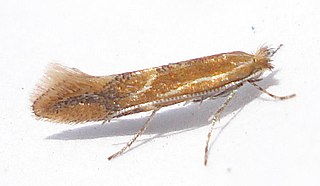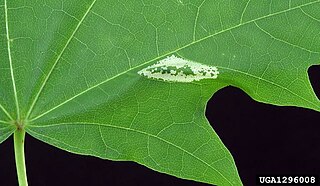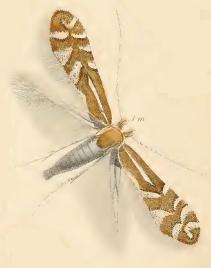
Gracillariidae is an important family of insects in the order Lepidoptera and the principal family of leaf miners that includes several economic, horticultural or recently invasive pest species such as the horse-chestnut leaf miner, Cameraria ohridella.

Phyllonorycter is a genus of moths in the family Gracillariidae.

Phyllonorycter joannisi is a moth of the family Gracillariidae. It is found in most of Europe.
Phyllonorycter baetica is a moth of the family Gracillariidae. It is found in Spain and France.
Phyllonorycter bartolomella is a moth of the family Gracillariidae. It is endemic to the Canary Islands and is known from Gran Canaria and Tenerife.
Phyllonorycter eugregori is a moth of the family Gracillariidae. It is known from the Czech Republic, Slovakia, Hungary, Croatia and Montenegro.
Phyllonorycter troodi is a moth of the family Gracillariidae. It is known from Cyprus.
Phyllonorycter strigulatella is a moth of the family Gracillariidae. It is found in the most of Europe, east to Russia and Japan.

Phyllonorycter stettinensis is a moth of the family Gracillariidae. It is found from Scandinavia and Finland to the Pyrenees, Corsica, Italy and Bulgaria and from Great Britain to Russia.
Phyllonorycter cytisifoliae is a moth of the family Gracillariidae. It is endemic to the Canary Islands and is known from Gran Canaria, La Palma, and Tenerife.

Phyllonorycter dubitella is a moth of the family Gracillariidae. It is found from Fennoscandia and northern Russia to the Pyrenees, Italy and Bulgaria and from Great Britain to Ukraine.

Phyllonorycter foliolosi is a moth of the family Gracillariidae. It is endemic to the Canary Islands and is known from La Palma and Tenerife.
Phyllonorycter helianthemella is a moth of the family Gracillariidae. It is found from Germany to the Iberian Peninsula, Italy and Greece and also on the Canary Islands.
Phyllonorycter hesperiella is a moth of the family Gracillariidae. It is known from the Iberian Peninsula and is probably also found in northern Africa.

Phyllonorycter lantanella is a moth of the family Gracillariidae. It is found in all of Europe, except Scandinavia, Ireland and the Balkan Peninsula.
Phyllonorycter lapadiella is a moth of the family Gracillariidae. It is known from Croatia, Serbia, Greece, France, Italy and Sicily.
Phyllonorycter pseudoplataniella is a moth of the family Gracillariidae. It is known from France and Germany.

Phyllonorycter schreberella is a moth of the family Gracillariidae. It is known from Europe, except northern Europe, Ireland and the Balkan Peninsula.

Phyllonorycter staintoniella is a moth of the family Gracillariidae. It is found from Sweden to the Pyrenees, Sardinia, Italy and Bulgaria and from Great Britain to Poland and Romania.

Lithocolletinae is a subfamily of insects in the moth family Gracillariidae. It is distributed worldwide, with most species in temperate regions.





